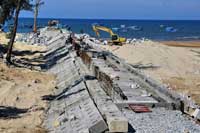
| Dike systems to protect capital | |||
Dike systems along Day and Bui rivers will be able to protect Ha Noi from historic-level rains because the city has worked to strengthen the systems, according to Do Duc Thinh, director of the municipal Flood and Dike Management. Thinh said the systems would be safe even with rain fall heavier than the historic levels that caused landslides at the foot of the dikes last year. After the heavy rains that caused holes in the dike along the Day River in Thuong and Trung hamlets in Vien Noi commune, Ung Hoa district, people living in the hamlets were forced to leave their crops due to interlacing cracks. "As many as 400 households in the hamlets had lost 4ha of cultivated land in the floods. Landslides occurred on the river’s left bank during the heavy rains this year," Thinh said. He said people who lived along the 2km dike in the commune were seriously threatened by landslides. People in Bui River’s right bank in My Ha and My Thuong hamlets in Huu Van commune, Chuong My district are also faced with potential landslides that can sweep away several construction projects in the locality. In an effort to resolve the situation, the municipal People’s Committee urges the Department of Agriculture and Rural Development to investigate and build embankments to prevent landslides in the area. According to vice chairman of the municipal People’s Committee Nguyen Van Phuc, it has been paying attention to upgrading the dyke systems since the merger of Ha Noi and Ha Tay province last year. About VND143 billion (US$8.4 million) has been invested in upgrading dikes.
The city invested VND5.1 billion ($318,700) to reinforce 2.7km of the dyke along the Bui river in Thanh Binh and Trung Hoa communes, Chuong My district. Thinh said around VND53 billion ($2.9 million) had also been supplied for two key embankments of Lien Tri in Dan Phuong district and Lien So in Thanh Tri district. He added that this year, the Government had provided over VND290 billion ($16.3 million) to the city for dike repairs. Currently, construction repairs and maintenance to the dike systems have been completed. "The above-mentioned dikes were repaired and ready for the upcoming rainy season," he said. Thinh said nine embankments in Da River’s right bank and Hong (Red) River’s right bank including Son Tay, Linh Chieu, Linh Son, Thuan My, Lien Tri, Ha Son, Chu Minh, Cam Phuong and Trang Viet had not been completed. "The stagnance is due to difficulties with land clearance and they are vulnerable to landslides," he added. Trinh said that the clearance required co-ordination among authorities. The population close to the embankments to be rehabilitated was not large. The city’s dike system, including the greater Ha Noi area, has 20 dike lines with a combined length of nearly 470km. By the end of this year, the city plans to finish clearing the land near the dikes and embankment systems. | |||
| VietNamNet + Viet Nam News |
